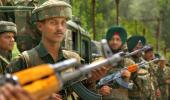'India is ahead only of Pakistan in the amount spent on each soldier a year.'
'The Indian military is a manpower-heavy throng that is poorly armed, equipped, and trained,' observes Ajai Shukla.

A well-respected Swedish think tank, which announced that India was now the world's third-biggest military spender, appears to have overestimated India's defence spend.
In making this determination, the Stockholm International Peace Research Institute (SIPRI) has put India's defence spend for 2019 at $71.1 billion, behind top spender US ($732 billion) and China ($261 billion), but ahead of Russia ($65.1 billion) and Saudi Arabia ($61.9 billion).
However, the most recent Indian budgetary figures (revised estimates) put India's defence expenditure for 2019-2020 at Rs 4.5 trillion, or about $59.7 billion.
This actually puts India at fifth, behind both Russia and Saudi Arabia.
It is unclear as to how SIPRI arrived at the $71.1 billion figure. The lower Indian budgetary figures include all aspects of defence spending, including salaries and defence pensions and civilian establishment of the ministry of defence (MoD), the Coast Guard, and Border Roads Organisation.
SIPRI is also incorrect in stating that India spends 2.7 per cent of its gross domestic product on defence. The most recent figure for 2019-2020 was 2.18 per cent of GDP.
However, an analysis comparing Indian defence spending (2020-2021 Budget figures) with five other countries -- the US, China, Russia, the UK and Pakistan -- shows interesting results.
India allocates, by far, the highest percentage of its defence budget on personnel costs, with a hefty 59 per cent going to salaries and pensions.
Even the US and the UK, which pay their soldiers relatively lavishly, spend only 38 per cent and 30.6 per cent, respectively, on personnel costs.
Unsurprisingly, the heavy outgo on personnel costs results in India having the lowest percentage spend on equipment modernisation, that is, expenditure.
While China and the UK spend 41 and 42 per cent of their defence budgets on modernisation, and even Pakistan spends a healthy 37 per cent, India can spare no more than 25 per cent of its defence budget on capital expenditure.
Countries like the UK plan equipment modernisation for a 10-year window, identifying exactly what weapon platforms they need to replace and allocating the funding for procuring replacements.
In contrast, India's 15-year Long Term Integrated Perspective Plan (LTIPP) is an endless wish list that the Budget cannot support since there are no priorities identified, nor alignment of requirements with future budgetary means.
India is ahead only of Pakistan in the amount spent on each soldier a year -- including salary, equipment and training costs.
While the US spends over half a million dollars per soldier and the UK spends $367,000, India spends a mere $43,000 per individual.
Consequently, the Indian military is a manpower-heavy throng that is poorly armed, equipped, and trained.
While China shows up well behind the US on almost every count, many defence analysts argue that China's expenditure figures are misleading.
These figures use conventional currency conversion, without adjusting for purchasing power parity (PPP), even though China builds most of its equipment indigenously rather than buying them at dollar prices from the international market.
Calculating from a PPP perspective, scholars such as Peter Robertson, professor at the University of Western Australia, put China's real military spending, as an equivalent of US spending, at $455 billion -- not far behind the actual US spending of $732 billion.











